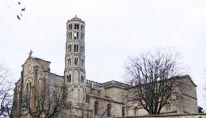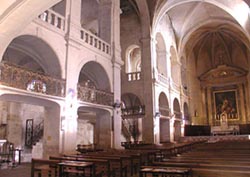
Originally called Ucetia, Uzès was a small Gallo-Roman oppidum. The town lies at the source of the Eure, from where a Romans aqueduct was built in the first century BC, to supply water to the local city of Nîmes. The most famous stretch of the aqueduct is the Pont du Gard, which carried fresh water over splendid arches across the River Gard (or Gardon) .
Like other cities in the Languedoc, Uzès was a haven for Jews in anti-Semitic western Christendom. The civilised and tolerant urban life of 5th-century Uzès contrasted with the rest of Europe. Jews were settled there as early as the 5th century. A Bishop of Uzès (Saint Ferréol) enjoyed their friendship. On this account complaint was made about him. As a result the bishop was obliged to change his attitude toward the Jews, compelling all those who would not become Christians to leave Uzès. By the 13th century, Uzès once again hosted a small community of Jewish scholars, as well as a community of Cathars.
Uzès was known for its serges. Like many cloth-manufacturing centers, the city and the surrounding countryside became strongly Protestant during the Wars of Religion in the 16th century. Many of the city's churches were destroyed and today only two remain.

![]()

![]() The
title of Duke of Uzès (duc d'Uzès), belonging to the family de
Crussol d'Uzès, is the premier title in the peerage of France, ranking
immediately after princes of the royal blood. The title of seigneur d'Uzès
is attested in a charter of 1088. The town has expanded round the 11th century
Tour Bermond, now located in the centre of the modern town. The family retain
their stronghold there. After Languedoc was annexed by France under the treaty
of Meaux in 1229, the dukes' military skill and loyalty to their new suzerain
propelled them through the nobility. On the death of the last Duc de Montmorency
(beheaded in Toulouse in 1632) the title of Premier Duke of France fell to Uzès.
Over the centuries, twenty-one dukes have been wounded or killed as Hereditary
Champions of France. It was part of the job of the incumbent Duke of Uzès
to defend the honour of the Queen Mother. Before the French Revolution it was
also his job to cry out on the death of the king, "Le Roi est mort. Vive
le Roi!" at his funeral.
The
title of Duke of Uzès (duc d'Uzès), belonging to the family de
Crussol d'Uzès, is the premier title in the peerage of France, ranking
immediately after princes of the royal blood. The title of seigneur d'Uzès
is attested in a charter of 1088. The town has expanded round the 11th century
Tour Bermond, now located in the centre of the modern town. The family retain
their stronghold there. After Languedoc was annexed by France under the treaty
of Meaux in 1229, the dukes' military skill and loyalty to their new suzerain
propelled them through the nobility. On the death of the last Duc de Montmorency
(beheaded in Toulouse in 1632) the title of Premier Duke of France fell to Uzès.
Over the centuries, twenty-one dukes have been wounded or killed as Hereditary
Champions of France. It was part of the job of the incumbent Duke of Uzès
to defend the honour of the Queen Mother. Before the French Revolution it was
also his job to cry out on the death of the king, "Le Roi est mort. Vive
le Roi!" at his funeral.

![]()

![]() A
Capuchin chapel, built in 1635 to house the mortal remains
of the Dukes of Uzès occupies the site of the 1st
century temple to the first Roman Emperor, Octavian Augustus.
The 11th century Romanesque Tour Fenestrelle ("Window
Tower"), with its paired windows, is probably the most
famous icon of the city. Private houses witness the wealth
that the textile trade brought to the town in the 16th century.
A
Capuchin chapel, built in 1635 to house the mortal remains
of the Dukes of Uzès occupies the site of the 1st
century temple to the first Roman Emperor, Octavian Augustus.
The 11th century Romanesque Tour Fenestrelle ("Window
Tower"), with its paired windows, is probably the most
famous icon of the city. Private houses witness the wealth
that the textile trade brought to the town in the 16th century.

![]() From
the 5th century until the French Revolution, Uzès
was the seat (cathedra) of a bishop. The first Bishop of
Uzès historically known is Constantius, present at
the Council of Vaison in 442. Other notable bishops include
St. Firminus (541-53) and St. Ferreol (553-81). St. Firminus
is locally venerated as Saint Firmin who supposedly provides
protection against plague. His relics rest in the Cathedral
of Saint Théodorit. Saint Theodoritus, priest and
alleged martyr, is the patron saint of the town. In time
the bishopric became one of the most extensive of Languedoc.
Bishops obtained the right to strike coinage and the right
to dispense justice, both signs of their temporal power.
In the 13th century, at the height of their power, the bishops
were able to purchase a part of the seigneurie of Uzès.
Guillaume de Grimoard du Roure (1310 – 1370) was consecrated
as Bishop of Uzès before becoming Pope Urban V. Like
other cloth manufacturing centers the town and the surrounding
areas were strongly Protestant
during the Wars of Religion in the 16th century. Even a
bishop, Jean de Saint Gelais (1531-60) converted to Protestantism.
The bishopric of Nîmes
like that of Uzès was extinguished during the French
Revolution. It was re-established as a separate diocese
in 1821, and a Papal Brief of 27 April 1877, granted its
bishops the right to add Uzès to their Episcopal
style. The Cathedral had been destroyed during the Albigensian
Crusade, later rebuilt, but destroyed again in the 16th
century during the Wars of Religion. It was rebuilt again
in the 17th century only to be stripped during the French
Revolution.
From
the 5th century until the French Revolution, Uzès
was the seat (cathedra) of a bishop. The first Bishop of
Uzès historically known is Constantius, present at
the Council of Vaison in 442. Other notable bishops include
St. Firminus (541-53) and St. Ferreol (553-81). St. Firminus
is locally venerated as Saint Firmin who supposedly provides
protection against plague. His relics rest in the Cathedral
of Saint Théodorit. Saint Theodoritus, priest and
alleged martyr, is the patron saint of the town. In time
the bishopric became one of the most extensive of Languedoc.
Bishops obtained the right to strike coinage and the right
to dispense justice, both signs of their temporal power.
In the 13th century, at the height of their power, the bishops
were able to purchase a part of the seigneurie of Uzès.
Guillaume de Grimoard du Roure (1310 – 1370) was consecrated
as Bishop of Uzès before becoming Pope Urban V. Like
other cloth manufacturing centers the town and the surrounding
areas were strongly Protestant
during the Wars of Religion in the 16th century. Even a
bishop, Jean de Saint Gelais (1531-60) converted to Protestantism.
The bishopric of Nîmes
like that of Uzès was extinguished during the French
Revolution. It was re-established as a separate diocese
in 1821, and a Papal Brief of 27 April 1877, granted its
bishops the right to add Uzès to their Episcopal
style. The Cathedral had been destroyed during the Albigensian
Crusade, later rebuilt, but destroyed again in the 16th
century during the Wars of Religion. It was rebuilt again
in the 17th century only to be stripped during the French
Revolution.
Uzès was the birthplace of Firmin Abauzit
(1679-1767), scholar who worked on physics, theology and philosophy and
Vice-Admiral
François-Paul Brueys D'Aigalliers, Count de Brueys, (1753-1798), the French
commander in the Battle of the Nile.
Events and Activities:
- Truffle Faire, January
- Foire à l'Ail (Garlic fair), June
|
|










